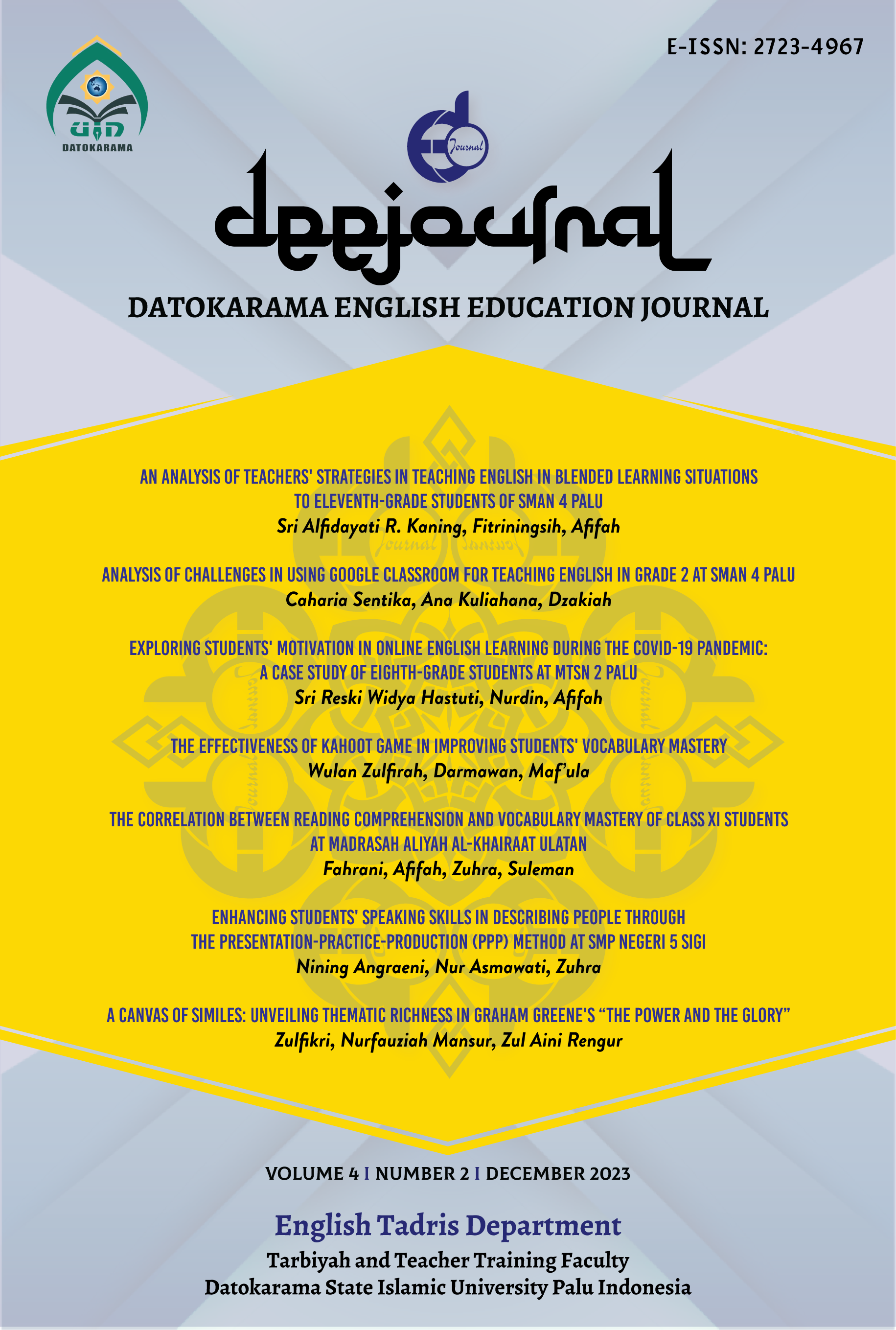Enhancing Students' Speaking Skills in Describing People through the Presentation-Practice-Production (PPP) Method at SMP Negeri 5 Sigi
DOI:
https://doi.org/10.24239/dee.v4i2.76Keywords:
Improving, speaking, fluency, PPP method, describing personAbstract
This study addresses the students' need for enhanced speaking skills, particularly in terms of fluency. The inquiry posed in this thesis originates from the question: Can the application of the Presentation, Practice, and Production (PPP) method contribute to the improvement of students' speaking abilities when describing a person at SMP Negeri 5 Sigi? The objective is to ascertain whether the use of the PPP method has a positive impact on students' proficiency in describing individuals. The research adopts a quantitative approach through quasi-experimental methods. The study encompasses the eighth-grade students of SMP Negeri 5 Sigi, comprising three classes. The experimental class comprises 20 students, while the control class consists of 20 students. Purposive sampling is employed to select students from classes VIII A and VIII B. The research findings demonstrate that the utilization of the Presentation Practice Production (PPP) method significantly enhances students' speaking skills, specifically in terms of fluency. This is evident from the mean scores of the experimental and control classes, which are 17.65 and 8.9, respectively. The calculated t-value of 4.26, with a degree of freedom (df) of 38 (20+20-2) and a significance level of 0.05, surpasses the critical t-table value of 2.00. Consequently, the hypothesis of the research is accepted, affirming that the implementation of the Presentation Practice Production method is effective in improving the speaking skills of eighth-grade students at SMP Negeri 5 Sigi.
References
Al Fauzan, Muh Saefullah. Improving Student’s Speaking ability through Mobile Social Networking. Muhammadiyah University. 2019.
Arikunto, Suharsimi. Prosedur Penelitian: Suatu Pendekatan Praktik, Edisi Revisi V. Jakarta: Pt Rineka Cipta, 2006.
Atma, Sayama. Raising Learners’ Level Of English Fluency Through Classroom Participation. Constantine: The People’s Democratic Republic Of Algeria Ministry Of High Education And Scientific Research Mentouri University. 2019.
Bullock, Richard. & Goggin, Maureen Daly. The Norton Field Guide to Writing With Reading. New York: W.W. Norton & Company. 2013.
Cohen, Et All. Research Methods In Education. London: Routledge Falmer . 2007.
Douglas, Brown. H. Teaching by Principles, An Interactive Approach to Language Pedagogy. Newyork: Addison Wesley Longman. 2001.
Harmer, Jeremy. How To Teach English. Edinburgh Gate: Longman. 1998.
_______. The Practice Of English Language Teaching. England: Longman. 2007.
Heaton. Writing English Language Test. England: Longman Group Limited. 1988.
Izzah, Alfiatul. The Use of PPP. Presentation Practice Production. Technique to Improve Speaking Skill. JP3. 2013.
Kane, Thomas S. The Oxford Essential Guide to Writing. New York: Oxford University Press. 2000.
Kurniati, Azlina. A Study on The Speaking Ability of The Second Year Students of SMK Telkom Pekanbaru. Riau University.
PW, Muh Mursyid. the Learning of Descriptive Text. Karangdadap: Handout SMPN 1.
Resha P.W. Developing Speaking Skill of Grade VIII Through Short Conversation. Palu: ELTS. 2015.
Sofan, Novi Nur. The Application of Presentation, Practice, Production (PPP) Technique toward Students’ Vocabulary Achievement. Pancasakti University Tegal: Academia. 2017.
Susanti, Ervi. & Amri, Zul. Speakingboard Game to Teach Speaking of Descriptive Text. State Univertsity of Padang: Journal of English Language Teaching, 2013.
Tahir, Saidna Zulfikar. Teaching Speaking English Through Yahoo Messenger. Jakarta: Qalam Media Pustaka, 2013.
Yuliani, Dewi. The Influence of using PPP Technique toward Students’ Speaking ability of The Eight Grade at Mts Darul Ulum Tanjung Bintang. Lampung: UIN Raden Intan. 2018.
Downloads
Published
How to Cite
Issue
Section
License
Copyright (c) 2023 Nining Angraeni, Nur Asmawati Nur Asmawati, Zuhra Zuhra

This work is licensed under a Creative Commons Attribution-NonCommercial 4.0 International License.


















